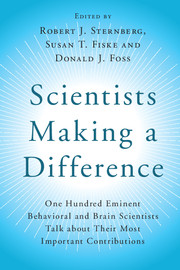 Scientists Making a Difference
Scientists Making a Difference Book contents
- Frontmatter
- Contents
- List of Contributors
- Foreword: Making a Creative Difference = Person × Environment
- Preface
- Part I Introduction
- Part II Biological Bases of Psychology: Genes, Brain, and Beyond
- Part III Cognition: Getting Information from the World and Dealing with It
- Part IV Development: How We Change Over Time
- Section A Cognitive Development
- Section B Social/Personality Development
- 50 The Power of Observational Learning Through Social Modeling
- 51 Human Development in Evolutionary-Biological Perspective
- 52 Transitions, Timing, and Texture: A Developmental Psychologist Goes Transdisciplinary
- 53 Longitudinal Cohort Research: Sowing, Nurturing, Waiting, Harvesting
- 54 A Conceptual and Empirical Bridge
- 55 Follow the Evidence, Ignore the Words
- 56 The Incredible Shrinking Conscious Mind
- 57 The Scientific Study of Self-Knowledge
- Part V Motivation and Emotion: How We Feel and What We Do
- Part VI Social and Personality Processes: Who We Are and How We Interact
- Part VII Clinical and Health Psychology: Making Lives Better
- Part VIII Conclusion
- Afterword: Doing Psychology 24×7 and Why It Matters
- Index
- References
53 - Longitudinal Cohort Research: Sowing, Nurturing, Waiting, Harvesting
from Section B - Social/Personality Development
Published online by Cambridge University Press: 05 August 2016
- Frontmatter
- Contents
- List of Contributors
- Foreword: Making a Creative Difference = Person × Environment
- Preface
- Part I Introduction
- Part II Biological Bases of Psychology: Genes, Brain, and Beyond
- Part III Cognition: Getting Information from the World and Dealing with It
- Part IV Development: How We Change Over Time
- Section A Cognitive Development
- Section B Social/Personality Development
- 50 The Power of Observational Learning Through Social Modeling
- 51 Human Development in Evolutionary-Biological Perspective
- 52 Transitions, Timing, and Texture: A Developmental Psychologist Goes Transdisciplinary
- 53 Longitudinal Cohort Research: Sowing, Nurturing, Waiting, Harvesting
- 54 A Conceptual and Empirical Bridge
- 55 Follow the Evidence, Ignore the Words
- 56 The Incredible Shrinking Conscious Mind
- 57 The Scientific Study of Self-Knowledge
- Part V Motivation and Emotion: How We Feel and What We Do
- Part VI Social and Personality Processes: Who We Are and How We Interact
- Part VII Clinical and Health Psychology: Making Lives Better
- Part VIII Conclusion
- Afterword: Doing Psychology 24×7 and Why It Matters
- Index
- References
Summary
Introduction
Our scientific contribution has been to study human development using the longitudinal birth-cohort method. This method starts with a list of all babies born in a defined place (typically a city or a country), within a defined period (typically a year). This list is referred to as a “cohort.” The babies are enrolled in the study (sometimes before they are born) and then followed and assessed repeatedly throughout their lives, as they grow up and grow old. Researchers and participants collaborate on the project together for many decades, which makes this method quite different from the sorts of research projects that other psychologists typically do. The research participants generously give of themselves over and over all their lives, vouchsafing the scientists the details of their most intimate, delicate, and even dangerous behaviors and experiences, as well as their body tissues.
The scientists, in turn, accept the ethical obligations to ask important questions, publish findings rapidly, preserve the data carefully for use in future years, and guard the participants’ confidentiality at all costs. We say “scientists” in the plural, because a longitudinal cohort study is far too ambitious an enterprise to be undertaken by one psychologist in his or her own lab. In fact, we are writing this chapter together because if we had worked alone, neither of us would appear in this book of high-achieving psychologists.
We think of a longitudinal cohort study as a scientific instrument, not unlike a large Hadron particle collider or a kilometers-wide radio-telescope antenna. Like one of these instruments, a cohort study is expensive, but pays for itself because it is a resource for many scientists who make multiple discoveries. Such scientific instruments are science-magnets; they attract collaboration among large numbers of scientists and staff from many different fields and nations. Like other large scientific instruments, a cohort study demands sustained dedication to fundraising. Instruments also require loving care and maintenance; in the case of a cohort study, this means dedication to keeping as many of the original cohort members as possible participating for decades. Our scientific careers have been devoted to two such studies. In both, well over 90 percent of the original cohort members still participate.
- Type
- Chapter
- Information
- Scientists Making a DifferenceOne Hundred Eminent Behavioral and Brain Scientists Talk about Their Most Important Contributions, pp. 249 - 255Publisher: Cambridge University PressPrint publication year: 2016
